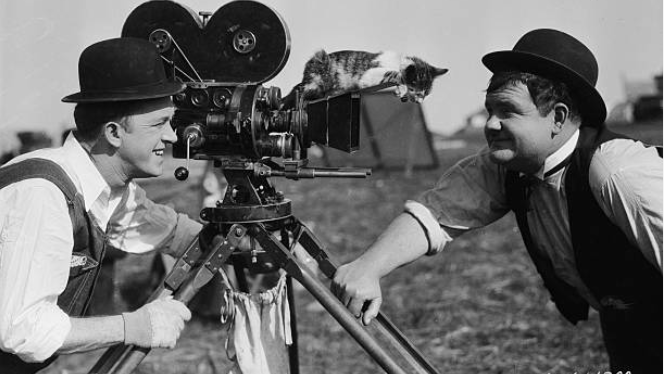Overview
In the 1920s, the silent film had been the predominant motion picture. However, talkies gained popularity after the premiere of The Jazz Singer on October 6, 1927. Laurel and Hardy were a comedy team that found success in both the silent shorts and talkies. Their career in the 1920s traces the evolution of motion pictures as they began the decade with silent films and ended it with a feature-length talkie.
Norvell Hardy
Norvell Hardy was born on January 18, 1892 in Georgia. Hardy adopted “Oliver” as his first name in honor of his father who died shortly after Hardy was born. Hardy, credited as O.N. Hardy, made his film debut in Outwitting Dad (1914). He was credited as “Babe Hardy” in a multitude of his subsequent films. He worked with several studios throughout his career including: Lubin Studios, Pathé Films, Edison Studios, and King Bee Studios. Hardy signed with Hal Roach Studios in 1924. Hardy was married to Madelyn Saloshin (1913-1921), Myrtle Reeves (1921-1937), and Virginia Lucille Jones (1940-1957). He died in Los Angeles on August 7, 1957 at sixty-five years old.
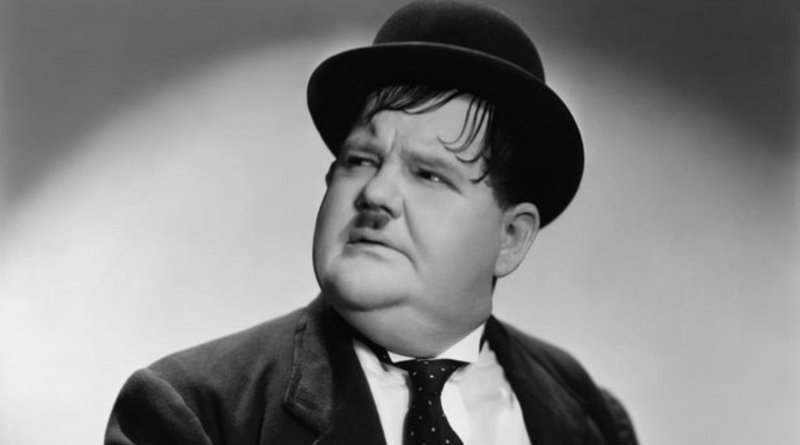
Arthur Stanley Jefferson
Arthur Stanley Jefferson was born on June 16, 1890 in England. He began his performing career as a touring comedian. He toured with Ted Desmond as the Barto Brothers. He also toured with Charlie Chaplin in a troupe created by Fred Karno. He took on the stage name Stanley Jefferson while touring with Karno’s troupe. Laurel visited America for the first time in 1910 with the Karno troupe. The last name “Laurel” was adopted shortly before the creation of The Lucky Dog (1921). In addition to his comedy work, Laurel worked as a writer and director in Hollywood. Laurel signed with Hal Roach Studios in 1925. Laurel’s common-law wife was Mae Dahlberg (1917-1925). He was married to Lois Neilson (1926-1935), Virginia Ruth Rogers (1935-1937, 1941-1946), Vera Ivanova Shuvalova (1938-1940) and Ida Kitaeva Raphael (1946-1965). Laurel had two children with Lois Neilson. After Hardy’s death in 1957, Laurel retired from acting and performing. He died on February 23, 1965 in Santa Monica, California at seventy-four years old.
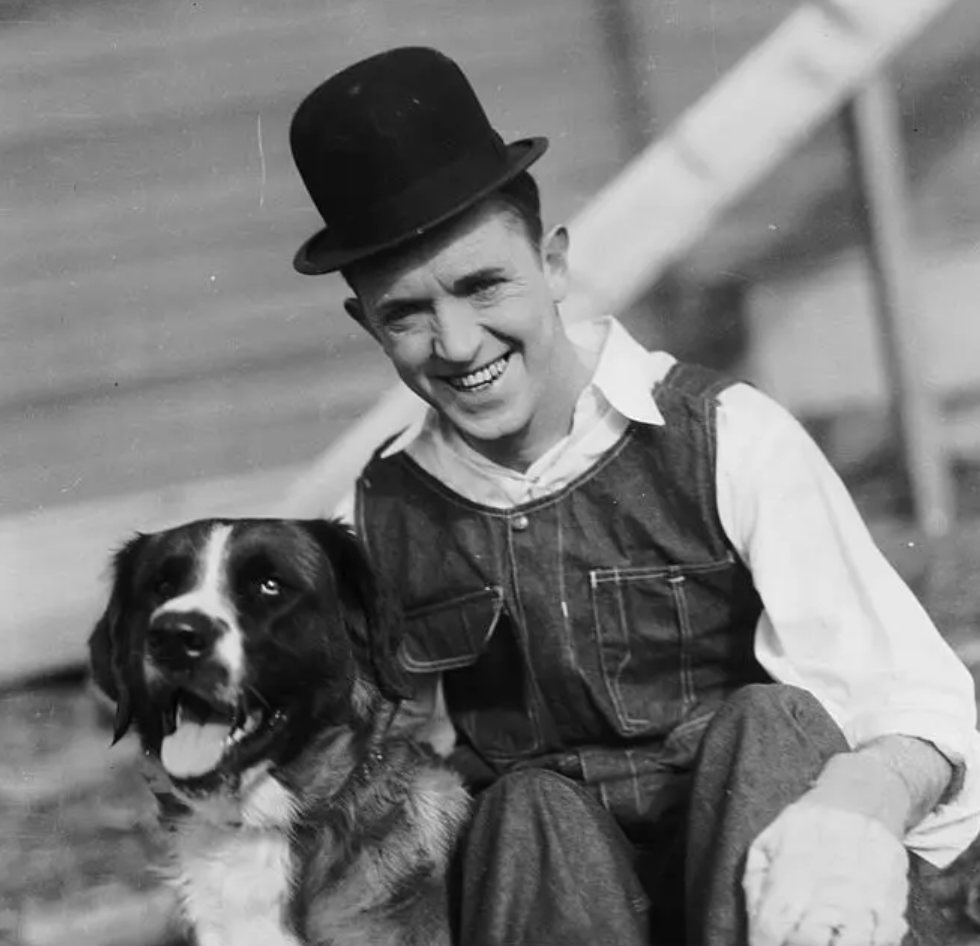
Co-Stars
Stanley Laurel and Oliver Hardy appeared in several films as co-stars before they became a comedy team. Their first film, released in 1921, was titled The Lucky Dog. This was a short, silent film. The two did not work together until the 1926 silent film 45 Minutes from Hollywood. In 1926, both Laurel and Hardy were a part of the Roach Comedy All Stars.
Metro-Goldwyn-Mayer).
Hal Roach Studios decided to capitalize on their previous success by continuing to pair Laurel and Hardy together. Laurel and Hardy, like many other comedians of the 1920s, took advantage of the slapstick style of comedy. Slapstick comedy entails wacky scenarios and physically violent interactions. One notable film they made before they became a team is Why Girls Love Sailors (1927). This film was the debut of Hardy’s “tie-twiddle.” Hardy explains the use of his tie as a comedic device, “I waved the tie in a kind of tiddly-widdly fashion, in a kind of comic way, to show I was embarrassed. I improved that little bit of business later on, and I used it for any number of situations…And that’s how the tie-twiddle was born.”1 John McCabe, Mr. Laurel and Mr. Hardy (Grosset & Dunlap, 1966), 123. . Other pre-team movies that were released in 1927 are: Duck Soup, Slipping Wives, Love ‘Em and Weep, With Love and Kisses, Sugar Daddies, Sailors, Beware!, Now I’ll Tell One, and Do Detectives Think?. Do Detectives Think?, was the first film in which Laurel and Hardy wore their typical costumes of bowler hats and suits.
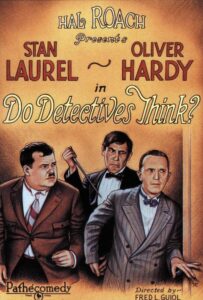
Laurel and Hardy
Laurel and Hardy co-starred in ten silent films. In 1927, Hal Roach, founder of Hal Roach Studios, announced the release of Laurel and Hardy comedies. Thus this began the era of Laurel and Hardy comedies. Putting the Pants on Philip (1927) was the first Laurel and Hardy movie to be filmed but was released on December 3, 1927. The first Laurel and Hardy movie to be released was The Second Hundred Years (1927), which premiered on October 8, 1927. Working with Hal Roach Studios, Laurel and Hardy were featured in six total movies in 1927 as a comedy team.
In 1928, Laurel and Hardy were featured in ten silent films. Laurel and Hardy were described by The Charlotte News as “very funny comedians” who “had ‘em holding their sides on Broadway”2“It Is To Laugh,” The Charlotte News, October 14, 1928, p. 34. in their silent film Two Tars (1928). Habeas Corpus and We Faw Down, both released in December 1928 were the first Laurel and Hardy films to feature music and effects that had not been seen in silent films. For many, such as those in Selma, Alabama, these films were “…the first sound comedy ever seen and heard…”3“First Sound Comedy To Show This Week,” The Selma Times-Journal, March 10, 1929, p. 14..
Laurel and Hardy performed in several different media in 1929: silent films, shorts with sounds and talkies. They released only two silent films: Big Business and Double Whoopee. Two Laurel and Hardy trademarks, seen in later films, were introduced in Double Whoopee. The first one was Hardy taking the lead in situations over Laurel. The second was Hardy’s excellent use of any form of writing utensil. Liberty, Wrong Again, That’s My Wife, Bacon Grabbers, and Angora Love were silent films with music and sound effects.
Laurel and Hardy’s first talkie, Unaccustomed As We Are was released on May 4, 1929. Their other 1929 talkies included: Berth Marks, Men O’War, Perfect Day, They Go Boom, and The Hoose-Gow. The addition of dialogue allowed for another comedic device to be used by Laurel and Hardy.
Metro-Goldwyn-Mayer).
The stock market crashed in October 1929. Despite this crash affecting filmmakers, the crash did not have a profound impact on Hal Roach Studios. However, Laurel lost approximately $30,000 after his bank closed. After the crash, Laurel and Hardy were featured in one short talkie (The Hoose-Gow), their first feature length talkie (The Hollywood Revue of 1945), and the short film Angora Love after the stock market crash. The pair also appeared in several advertisements for Metro-Goldwyn-Mayer.
Post-1920s Career
Laurel and Hardy continued to perform together until 1955. They appeared in fifty-two shorts and feature-length films in the 1930s. In the 1940s, they appeared in ten feature films and one short for a total of eleven films. Atoll K was their only film released in the 1950s. In total, they appeared in 107 films together, including silent shorts and feature-length talkies. Laurel and Hardy performed on radio in the late 1940s until the 1950s, and performed skits on stage.
Both Laurel and Hardy are remembered in a positive light and as pioneers in comedy. They are almost always remembered together, as a comedic duo. Their films continue to play on television in present day.
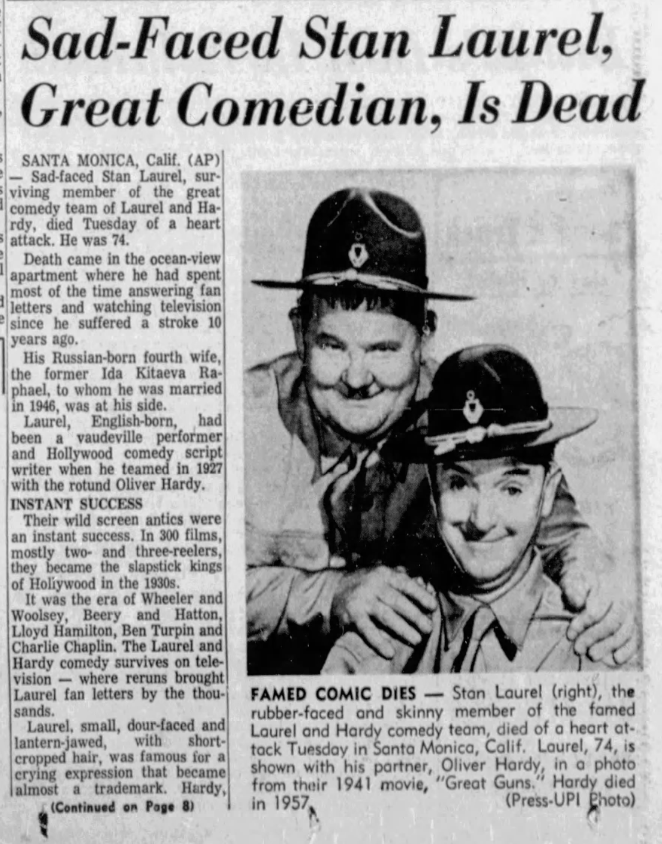
Significance
Laurel and Hardy films are representative of 1920s film technology. The evolution from silent shorts to talkies demonstrates the improvement of technology in the 1920s. In between the silent films and the introduction of talkies, silent films featured sound effects and music. Sound effects allowed for performers such as Laurel and Hardy to incorporate off screen sounds. There are two iconic uses of off-screen sounds by Laurel and Hardy. The first occurred in Men O’War (1929), where a crash sound is heard off-screen. This movie is credited for the creation of that movie device. Another use of the newly incorporated sound effects occurred in The Perfect Day (1929) when the noise of an anvil was used as a sound effect when Hardy hit Laurel over the head.
The shorts of Laurel and Hardy allow a glimpse into life of the 1920s. The clothing of background characters reflects what was popular during the decade. Their bits, jokes and dialogue also allow for a glimpse into the predominant sense of humor of the time period.
Bibliography
“Comedian Oliver Hardy Dies, Had Suffered Stroke Last Year,” The Daily Home News, August 7, 1957, p. 17.
“First Sound Comedy To Show This Week,” The Selma Times-Journal, March 10, 1929, p. 14.
Hal Roach Studios. “The Lucky Dog,” December 1, 1921. https://youtu.be/8CKO5uu-GJ0.
“It Is To Laugh,” The Charlotte News, October 14, 1928, p. 34.
“Sad-Faced Stan Laurel, Great Comedian, Is Dead,” Atlantic City Press, February 24, 1965, p. 10.
———. “Unaccustomed as We Are,” May 4, 1929. https://youtu.be/2BHU6MPJ-_o.
McCabe, John. Mr. Laurel and Mr. Hardy. Grosset & Dunlap, 1966.
Redfern, Nick. “Shot Length Distributions in the Short Films of Laurel and Hardy, 1927 to 1933.” Cine Forum 14 (2012). https://citeseerx.ist.psu.edu/document?repid=rep1&type=pdf&doi=9741a1aecfb219f30fb09128dc163aea0ebcf6dc.
The Editors of Encyclopaedia Britannica. “Laurel and Hardy.” www.britannica.com, July 20, 1998. https://www.britannica.com/topic/Laurel-and-Hardy#ref632902.
The Editors of Encyclopedia Britannica. “Slapstick.” www.britannica.com, July 9, 2018. https://www.britannica.com/art/slapstick-comedy.

Michelle Kukan is a spring 2023 student of Discovering Digital History at Ramapo College. She is a sophomore studying history, American studies and museum & exhibition studies. She is a volunteer for Mahwah Museum’s Veterans Project and works on the Jane Addams Paper Project.

